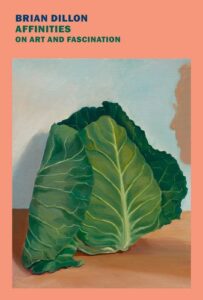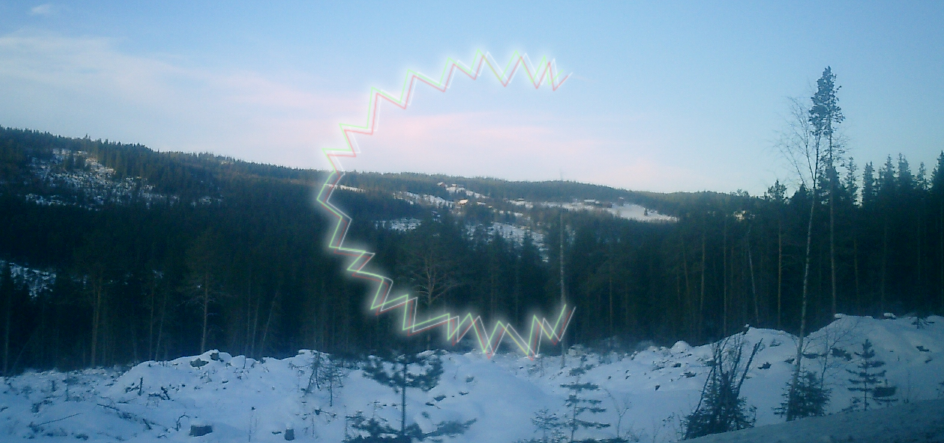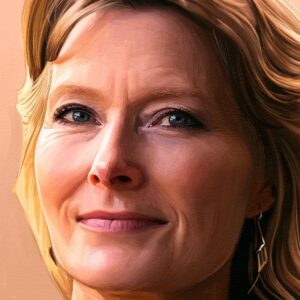I was fifteen years old when it first appeared. I’d cycled to school as usual, survived a flummoxing maths lesson without shame, settled into the day’s second period and opened my science textbook, when I found I could not see straight. I blinked hard at the page. Something remained in the way. I tried to get the object in focus, the better to banish it, but it would not resolve. The thing was not exactly there, no blurred patch or dark hole in space, instead pure absence, as if one side of reality had simply dropped away.
I remember thinking that whatever this was, it would be hard to put into words. I looked up from the book and there the nothing was still, obscuring several classmates, half the blackboard and an array of chemistry equipment on the teacher’s desk. Surely I was going blind.
I must have seemed in some distress because this teacher, a sour and sometimes violent man, quickly sent me home. (It occurs to me only now, thirty-seven years later, to ask: why would you let out into the streets a teenager in your care, who suddenly could not see?) I cycled four miles through the South Dublin suburbs in a state of extreme anxiety, more for my sight than my safety.
For a while in my teens I was a reckless and inattentive cyclist, and had ridden twice into static cars on my way home from school—but I was sure now that habit and what remained of my vision would get me home. When I was a few minutes from the house, an old man with a walking stick started to cross the road ahead of me, vanishing into the void in my field of vision, emerging again on the footpath opposite, just in time.
The pain set in while I was still cycling, and as I was heaving the bike into our garden shed my head throbbed violently. I had never felt the like in my life. In the kitchen I tried explaining to my mother that I had a headache, but I had forgotten the word—instead I told her I had a grenade, a really bad grenade. It must have been she who first used the word migraine. The pain was now so fierce I could hardly speak, but my vision had begun to clear as I went up to bed.
It was now late morning. My mother closed the curtains, and I spent the afternoon curled there, actually whimpering. Some pains, so we say, come in waves; this one seemed to arrive like a tide, saturating mind and body. I kept thinking the day must be done, but I’d look at my alarm clock and find only a few minutes had passed since I last checked the time.
I remember thinking that whatever this was, it would be hard to put into words.Around six in the evening I got up and vomited, went back to bed, found the headache had faded, and went downstairs for dinner, feeling as if I’d been sluiced or drenched (imagine a sheep dragged from its chemical dip) and I’d risen lighter, cooler, made of air. My father was home from work, my brothers from school; I think we all knew that if it was a migraine, this was something a person might be prone to. But the subject was soon dropped, and I sat that evening in front of the television (not, I learned later, a very good idea during or after a migraine) silently amazed at what had happened.
Years later, when this sort of episode returned, I could spend days afterwards feeling stupefied and weary, also fretful in case it happened again before very long. But aged fifteen I quickly forgot about the pain and fear, and there were no physical aftereffects the following day. I was left only with a sense that for the hour or so that I could not see properly, something inside me had been switched to another channel, been partially detuned or afflicted with interference—snow, as we used to say when it happened on the TV screen.
I felt, in other words, a little less human, oddly electronic. The feeling, it seems, is not unique. In the medical archive of the Wellcome Collection in London, there is an anonymous drawing from 1985 (the year of my first attack), a self-portrait in which the patient’s face is obscured by the “Migraine Computer”: something like an arcade game of the period, with joystick and screen, on which a jagged form seems to pulse and glow.
*
Here is another picture, if that is the right word for an image that depicts or describes the interruption of vision. The illustration is mostly a field of black—richly printed, in its first published version, by G. West & Company—on which appears a series of white forms, built up in zigzag or herringbone strokes, like fine Elizabethan brickwork. The largest forms pointed or appointed in color. Subsequent reproductions, especially in black and white, tend to miss the jewelry quality of what is laid out on the inky velvet ground. A trove, a cache, the spoils of a dream heist: quite unreal, instead conjured, abstracted, fantasized.
There are ten of them, these—what? Entities? Artifacts? Apparitions? Eight arrayed in the upper quarter of the image, in two rows. Left to right each row records the birth and growth of the thing, from a spark that’s hardly there at all, contending with the dark, to a small c, then its uppercase sibling C, and finally a shape like the claw of a crab or lobster, snapping away at the righthand edge of the image. Image of what, exactly?
The form, at first zygotic, as if something is really coming to life, also reminds me of diagrams we were made to draw at school of a river’s meanders, slowly orphaned from the main stream and turned into oxbow lakes. Hard to look at the shapes in this darkling image without falling (or is it ascending?) into metaphor. I’m not the first to say immediately what they remind me of, to say what they are not.
Below the eight smaller figures—which are numbered in tiny white superscript, as though footnoting features in a landscape—sits the largest of the ten, like a mountain range at dawn, its peaks catching the light while lowlands remain in shadow. An unassailable redoubt, a fortification made by the earth itself. And over on the right: a settlement of sorts? A burial mound or ring fort? The final form, which suggests the whole thing may be starting to sink away, like an archaeological remnant.
Enough metaphorical diversion: concentrate. What you are seeing is a scintillating scotoma, one of many manifestations of migraine aura: a bout of physical, mental or emotional disturbance that precedes the arrival of pain but may follow, too, the end of the headache itself. To scintillate is to sparkle, to give off sparks. At the time this image was made, scintillating scotoma was not yet the name for the phenomenon it shows, although the form and its vibrations or coruscations were well known, if not understood.
The image derives from a paper published in 1870 in the Philosophical Transactions of the Royal Society. It was written by the English physician Hubert Airy, and “communicated” to the Society by the author’s father, Sir George Airy, who held the post of Astronomer Royal from 1835 to 1881. The article is titled “On a Distinct Form of Transient Hemiopsia,” and in it Airy fils, who has been both observer and patient, notes “the outward spread of the cloud, its arched shape, its serrated outline, with smaller teeth at one end than at the other, its remarkable tremor, greater where the teeth are greater, its ‘boiling,’ its tinge of scarlet, and its sequel of partial aphasia and loss of memory.”
These are all, Airy writes, “new features,” unrecorded by any previous researcher in the field. He had himself already attempted, two years before, to capture the visible aspect of aura, if not its more elusive emotional and intellectual symptoms: “A bright stellate object, a small angled sphere, suddenly appears in one side of the combined field.” He had first experienced it in 1854, as a student of eighteen:
In its height it seemed like a fortified town with bastions all around it, these bastions being coloured most gorgeously. If I could put my pen into the space where there was this dimness, I could not see it at all, I could not even distinguish the colour of the ink at the end. All the interior of the fortification, so to speak, was boiling and rolling about in a most wonderful manner as if it was some thick liquid all alive.
The kernel grows, ramifies like a crystal, feathering like frost on a windowpane. These mixed metaphors are mine, but Airy, whose very name seems suited to describing evanescence, has already supplied his own imagery. It is like looking through watered silk, he tells us. The points of the scotoma resemble the erect tails (or does he mean fins?) of sharks, or sharp waves on windblown water. They are like abstract details in a mosaic or a Turkish carpet. Airy’s most striking comparison, however, is this: “It may be likened to the effect produced by the rapid gyration of small water beetles as they are seen swarming in a cluster on the surface of the water in sunshine.”
Years ago, in high summer, walking in woods by a shallow canal or “leat”—the place had once been a gunpowder factory—I spotted just such a cloud of insects teeming on the surface, and I stopped and stared long enough to get my phone out and make a video of this congregation of excitable creatures, which are so slight they might themselves be made of water, air or light.
Their crepitations on the surface of the water are so subtle that it hardly moves, and you can see the pinpricks of their feet in the meniscus, holding it down like the tufting of a mattress. They don’t look much like a scintillating scotoma until a shadow falls on the water—the shadow of my phone, for example—and the startled water beetles skate about in panic, drawing ripples and wakes that do indeed, Hubert Airy is right, call to mind the restless geometry of the scotoma.
The visual effects—special effects, we might say—of migraine had been well known to early medicine. Among the Greeks, Hippocrates writes of one sufferer who in advance of pain and nausea “seemed to see something shining before him like a light.” Optical oversensitivity is typical, says Aretaeus of Cappadocia: “For they flee the light; the darkness soothes their disease.” The illness known in English as megrim was not always associated with seeing things (or not seeing things); historians of medicine have gone looking for unsuspected migraine in descriptions of strange, jagged visions.
Blaise Pascal sometimes saw a cavity or precipice gaping away to his left, and in his manuscripts would insert peculiar zigzag patterns reminiscent of migrainous designs of eye or mind. And here much later is Hilary Mantel, in her memoir Giving Up the Ghost (2003), describing her own symptoms: “Small objects will vanish from my field of vision, and there will be floating lacunae in the world, each shaped rather like a donut with a dazzle of light where the hole should be. Sometimes there are flashes of gold against the wall, darting chevrons, like the wings of small quick angels.”
Transient teichopsia, Airy called his own spiky visions. Teichos means wall, denoting a resemblance to the angled walls of a fortified town. Architectural visions, in other words: Airy’s father, who drew his own interpretations, said they were like “the ornaments of a Norman church.” The younger Airy was struck by the prevalence of this affliction among learned men, especially scientists, more especially astronomers. Perhaps their eyes were taxed by reading or by the rigors of minute and distant observation.
Whatever the cause, according to Hubert Airy such patients’ professional skills meant they were well equipped to describe their symptoms: “The votaries of Natural Philosophy are especially qualified by their habits of accurate observation to contemplate attentively any strange apparition, without or within.”
One final image or metaphor from Airy’s repertoire. The zigzag figure, he writes, is “a veritable ‘Photograph’ of a morbid process going on in the brain.” Scare quotes aside, and the weakening effect of “veritable,” this is still an extraordinary statement. It has required some considerable labour and skill to bring Airy’s “Diagram of Transient Teichopsia” before the members of the Royal Society and the readers of their journal.
First the art of Airy’s original, and second the efforts of G. West & Company to convey accurately the colors and shading of Airy’s illustration. But what they had communicated, Airy now tells us, was itself a representation of some process unseen, which makes of the patient, natural philosopher or not, a kind of camera, but a camera that can see what is not there.
Hard to look at the shapes in this darkling image without falling (or is it ascending?) into metaphor.I was not, it transpired, very prone to migraine, at least not in my teens: one or two more attacks before I left school, and then nothing. At college, a couple of false alarms when the aura arrived while I was reading at the library, but no headache or nausea followed. Eventually, when sympathizing with friends or colleagues, I talked about migraine as something I’d fleetingly suffered when I was young. And then, around forty, a sudden reprise, this time obviously linked to sleeplessness, fatigue or exercise.
And now, also, with more pronounced auras: a sense of intellectual and creative confusion or abeyance, wildly varying levels of pain and a long, anxious, some- times even tearful prodrome (as I learned it was called) lasting days. In the autumn of 2018, a year or so into an academic post for which I was insanely unsuited, and which I worried would stop me writing for good, I spent a week in a cycle of near-blindness and incredible pain, unable to look at a page or screen, or even out of the window, in case it started up again—which it did anyway, in spite of precautions. In my perplexity I took so many painkillers that when I closed my eyes I seemed to be speeding through a sort of tunnel lined with ornate, spangled fabrics. A hypnagogic horror show—also very kitsch, very “psychedelic.”
Recently, I’ve narrowed my incidence of migraine down to a single, avoidable circumstance: during early-morning runs, I should not complete more than three or four circuits of the large complex of flats where I live without a rest. Otherwise, within an hour or so, just as I’m settling in to the day’s reading or writing, the page will start to blur, a certain unreality arriving at the same time, and I’ll turn my head away from my notebook or laptop and catch the first germinating twitch or flash of the scotoma.
Hubert Airy’s architectural fantasia being birthed, persisting in nucleo for a while, hard to place in the field of vision, as if the eye had been caught by sunlight on a faraway window, a boat at sea, a car speeding out of view in the distance. Sometimes, because usually these days the pain, if it comes, is not so severe, or may be kept at bay with immediate Tylenol, I will calmly close my eyes and watch the bright fortification being built, filling a portion of my sight on one side or the other, slowly floating towards me.
And at such moments I always think of George and Hubert Airy, with their more or less elaborate sketches, detailed letters describing the latest manifestations, expanding vocabulary for what they are seeing. And once or twice I’ve caught myself trying to hold onto and list—forgetting words is a common symptom— some terms for the bristling shapes I’m seeing. Rampart, bulwark, parapet, buttress, outwork, projection, breastwork, redoubt, barbican.
__________________________________

Excerpted from Affinities: On Art and Fascination by Brian Dillon. Copyright © 2023. Available from New York Review Books.



